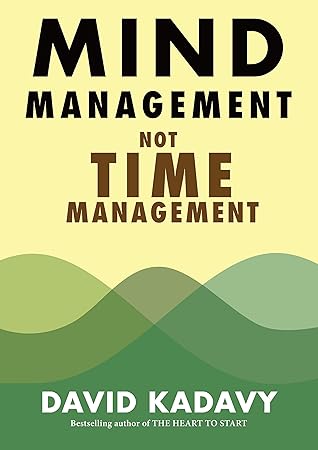More on this book
Community
Kindle Notes & Highlights
Mind Management, Not Time Management: Productivity When Creativity Matters (Getting Art Done Book 2)
by
David Kadavy
Read between
November 7 - November 15, 2023
Scientists who study creativity define it as coming up with something both novel and useful.
These days, the mental work that matters isn’t about following a series of steps. It’s about finding your way to a novel and useful solution.
Your edge as a human is not in doing something quickly. No matter how fast you move, a computer can move faster. Your edge as a human is in thinking the thoughts behind the doing. As entrepreneur and investor Naval Ravikant has said, “Earn with your mind, not your time.”
Taylorism swept through the industrial world, and brought productivity forward by leaps and bounds. What we now think of as “time management” is a child of Taylorism.
Taylor’s big contribution to productivity was that he thought of time as a “production unit.”
Everything around us is set up with the assumption that time is extremely valuable.
But there’s something we’re forgetting when we treat time as if it were money.
Exploit any resource enough, and you’ll eventually stop getting benefits.
Taylor also needed to prescribe rest to that worker. So, at some point, time was no longer the only resource for Taylor to optimize. Taylor had to leave some time empty to truly get optimal output from his workers.
“the point of diminishing returns.”
the point of negative returns.
in today’s world, where creative thinking is key to being productive, you can’t get more output simply by optimizing time.
Our time worship drives us to do strange things to save time.
time worship permeates American culture, affecting the way others treat you, no matter how much you try to forget about time:
Thirty percent of working Americans are apparently so short on time that they now get less than six hours of sleep.
We have the gall to refer to unused time as “free” time. Do we call our unused money “free” money? No!
Time is apparently money when your boss is using it, yet somehow it’s “free” time when it’s leftover for you to
use.
This highlight has been truncated due to consecutive passage length restrictions.
Time you don’t use now pays dividends in the future.
Alice Walker said, “In order to invite any kind of guest, including creativity, you have to make room for it.”
The first false assumption time management makes is that time management treats time as a commodity.
Rhythms within our bodies and within the world around us make each hour different from the next. Some hours are better for thinking analytically. Other hours are better for thinking creatively.
The second false assumption that time management makes is that being productive is about producing.
Yet the impact of what you produce in one minute can vary greatly when compared to the impact of what you produce in the next minute.
The thing that determines whether what you produce does extraordinarily well or extraordinarily poorly is the quality of your ideas.
when you look at how ideas happen, you can’t connect the quality of those ideas to the time you spend on them.
It takes no time to have an idea, yet you have that idea in that instant because of things you did
long before.
“Things are not difficult to make; what is difficult is putting ourselves in the state of mind to make them.”
today’s productivity is about
creating the conditions within your mind to have valuable thoughts.
Time management optimizes the resource of time. Mind management optimizes the resource of creative energy.
“The Four-Criteria Model for Choosing Actions in the Moment,”
four criteria you can apply, in this order: context, time available, energy available, and priority.”
What if you managed your creative energy so well that, instead of staring, puzzled, at your to-do list, it was obvious what you should do at that time. This level of mastery is possible with mind management.
What work am I in the mood to do right now? Then, ask yourself, What do I need to do that fits that mood?
when our mental state is aligned with the task at hand, suddenly everything is easier.
But sometimes, something simply needs to get done now. In these cases, you can ask yourself, What mood would be most conducive to doing this work? Then, ask yourself, When was the last time I felt that way? Finally, see if you can replicate the conditions that put you in that mood.
I began to notice hidden boundaries in my thinking.
let go of the notion that we can squeeze more from our time. Instead, let’s think about how to get more from our minds.
Creative work is so unpredictable because progress doesn’t happen linearly. Instead, our creative projects iterate through the Four Stages of Creativity.
I’ve identified Seven Mental States that effortlessly move creative projects forward.
how to leverage the power of Creative Cycles.
By timing your efforts according to Creative Cycles, you’ll make more progress with less sweat.
Creative Systems turn your projects into repeatable systems
repeatable systems that are flexible enough and that provide enough space to account for the fickle...
This highlight has been truncated due to consecutive passage length restrictions.
You can plan the perfect system, but it’s only useful if it can stand up to the unexpected and unplanned.
Creating in Chaos. Learn how to keep your projects moving forward when life’s inevitable chaos gets in the way.
the key to doing creative work is to get into the right state to do that work.
Creative work such as writing requires both “divergent” and “convergent” thinking. These two types of thinking are at odds with one another, so this presents a challenge.


